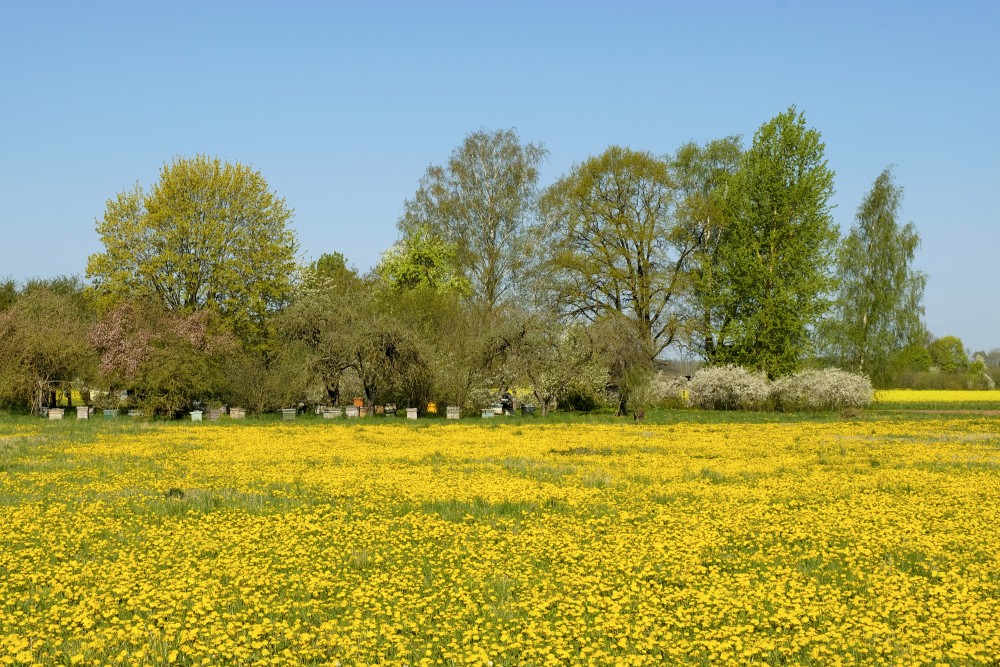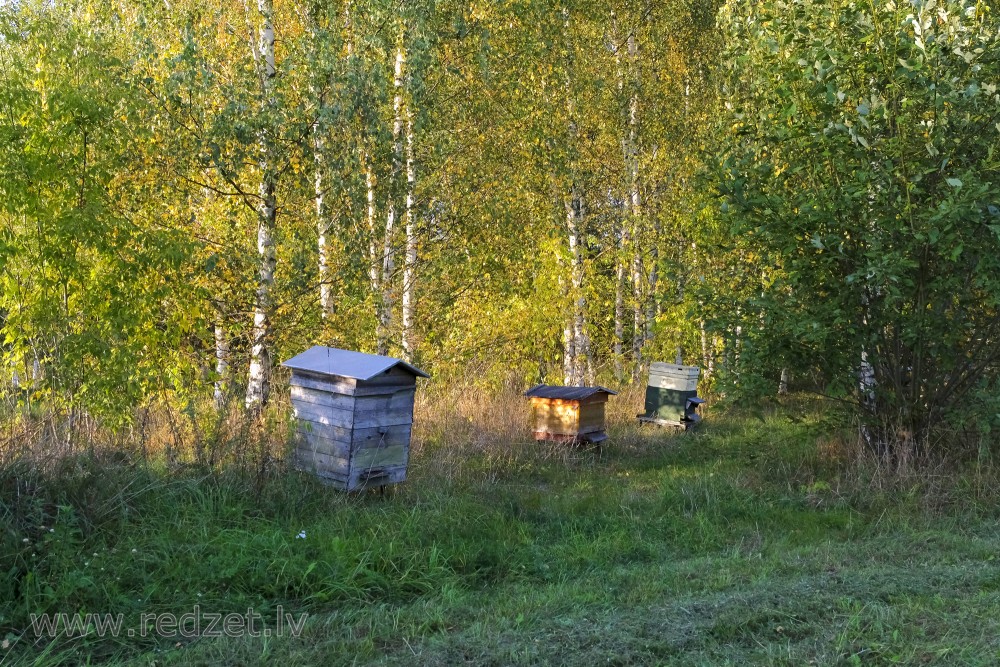Beehive
A beehive is an enclosed, man-made structure in which some honey bee species of the subgenus Apis live and raise their young. Though the word beehive is commonly used to describe the nest of any bee colony, scientific and professional literature distinguishes nest from hive. Nest is used to discuss colonies which house themselves in natural or artificial cavities or are hanging and exposed. Hive is used to describe an artificial, man-made structure to house a honey bee nest. Several species of Apis live in colonies, but for honey production the western honey bee (Apis mellifera) and the eastern honey bee (Apis cerana) are the main species kept in hives.
The nest's internal structure is a densely packed group of hexagonal prismatic cells made of beeswax, called a honeycomb. The bees use the cells to store food (honey and pollen) and to house the brood (eggs, larvae, and pupae).
Beehives serve several purposes: production of honey, pollination of nearby crops, housing supply bees for apitherapy treatment, and to try to mitigate the effects of colony collapse disorder. In America, hives are commonly transported so that bees can pollinate crops in other areas.[3] A number of patents have been issued for beehive designs.
Honey bee nests
Honey bees use caves, rock cavities and hollow trees as natural nesting sites. In warmer climates they may occasionally build exposed hanging nests. Members of other subgenera have exposed aerial combs. The nest is composed of multiple honeycombs, parallel to each other, with a relatively uniform bee space. It usually has a single entrance. Western honey bees prefer nest cavities approximately 45 litres in volume and avoid those smaller than 10 or larger than 100 litres. Western honey bees show several nest-site preferences: the height above ground is usually between 1 metre (3.3 ft) and 5 metres (16 ft), entrance positions tend to face downward, Equatorial-facing entrances are favored, and nest sites over 300 metres (980 ft) from the parent colony are preferred. Bees usually occupy nests for several years.
The bees often smooth the bark surrounding the nest entrance, and coat the cavity walls with a thin layer of hardened plant resin called propolis. Honeycombs are attached to the walls along the cavity tops and sides, but small passageways are left along the comb edges. The basic nest architecture for all honeybees is similar: honey is stored in the upper part of the comb; beneath it are rows of pollen-storage cells, worker-brood cells, and drone-brood cells, in that order. The peanut-shaped queen cells are normally built at the lower edge of the comb.
Ancient hives
Bees were kept in man-made hives in Egypt in antiquity. The walls of the Egyptian sun temple of Nyuserre Ini from the 5th Dynasty, dated earlier than 2422 BC, depict workers blowing smoke into hives as they remove honeycombs. Inscriptions detailing the production of honey are found on the tomb of Pabasa from the 26th Dynasty (c. 650 BC), and describe honey stored in jars, and cylindrical hives.
The archaeologist Amihai Mazar cites 30 intact hives that were discovered in the ruins of the city of Rehov (2,000 residents in 900 BC, Israelites and Canaanites). This is evidence that an advanced honey industry existed in Palestine, approximately 4,000 years ago. The beehives, made of straw and unbaked clay, were found in orderly rows, with a total of 150 hives, many broken. Ezra Marcus from the University of Haifa said the discovery provided a glimpse of ancient beekeeping seen in texts and ancient art from the Near East. An altar decorated with fertility figurines was found alongside the hives and may indicate religious practices associated with beekeeping. While beekeeping predates these ruins, this is the oldest apiary yet discovered.
Traditional hives
Traditional beehives simply provided an enclosure for the bee colony. Because no internal structures were provided for the bees, the bees created their own honeycomb within the hives. The comb is often cross-attached and cannot be moved without destroying it. This is sometimes called a fixed-frame hive to differentiate it from the modern movable-frame hives. Harvest generally destroyed the hives, though there were some adaptations using extra top baskets which could be removed when the bees filled them with honey. These were gradually supplanted with box hives of varying dimensions, with or without frames, and finally replaced by newer modern equipment.
Honey from traditional hives was typically extracted by pressing – crushing the wax honeycomb to squeeze out the honey. Due to this harvesting, traditional beehives typically provided more beeswax, but far less honey, than a modern hive.
Four styles of traditional beehives include; mud hives, clay/tile hives, skeps and bee gums.
Modern hives
The earliest recognizably modern designs of beehives arose in the 19th century, though they were perfected from intermediate stages of progress made in the 18th century.
Intermediate stages in hive design were recorded for example by Thomas Wildman in 1768/1770, who described advances over the destructive old skep-based beekeeping so that the bees no longer had to be killed to harvest the honey. Wildman, for example, fixed a parallel array of wooden bars across the top of a straw hive or skep (with a separate straw top to be fixed on later) "so that there are in all seven bars of deal" [in a 10-inch-diameter (250 mm) hive] "to which the bees fix their combs". He also described using such hives in a multi-story configuration, foreshadowing the modern use of supers: he described adding (at the proper time) successive straw hives below, and eventually removing the ones above when free of brood and filled with honey, so that the bees could be separately preserved at the harvest for a following season. Wildman also described a further development, using hives with "sliding frames" for the bees to build their comb, foreshadowing more modern uses of movable-comb hives. Wildman acknowledged the advances in knowledge of bees previously made by Swammerdam, Maraldi, and de Reaumur – he included a lengthy translation of Reaumur's account of the natural history of bees – and he also described the initiatives of others in designing hives for the preservation of bee-life when taking the harvest, citing in particular reports from Brittany dating from the 1750s, due to Comte de la Bourdonnaye.
In 1814 Petro Prokopovych, the founder of commercial beekeeping in Ukraine, invented one of the first beehive frames which allowed an easier honey harvest.
The correct distance between combs for easy operations in beehives was described in 1845 by Jan Dzierżon as 1½ inches from the center of one top bar to the center of the next one. In 1848, Dzierżon introduced grooves into the hive's side walls replacing the strips of wood for moving top bars. The grooves were 8 mm × 8 mm (0.31 in × 0.31 in), the spacing later termed bee space. The Langstroth hive was the first successful top-opened hive with movable frames. The Langstroth hive was however a direct descendant of Dzierżon's hive designs.
Hives can be vertical or horizontal. There are three main types of modern hive in common use worldwide:
- the Langstroth hive
- the Top-bar hive
- the Warre hive
Most hives have been optimized for Apis mellifera and Apis cerana. Some other hives have been designed and optimized for some meliponines such as Melipona beecheii. Examples of such hives are the Nogueira-Neto hive and the UTOB hive.
en.wikipedia.org


